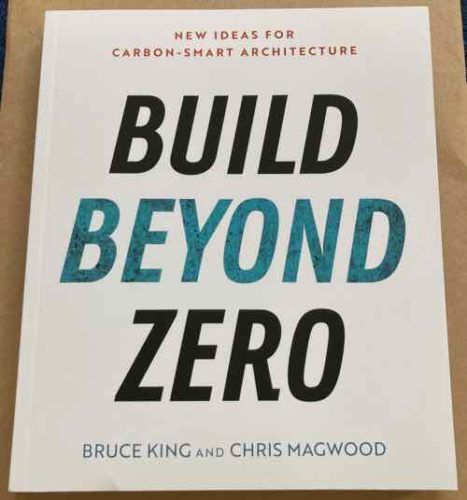New Book — “Build Beyond Zero: New Ideas for Carbon-Smart Architecture” by Bruce King and Chris Magwood
 With all the talk of electric vehicles it’s easy to forget that buildings are a major contributor toward climate change. Building low or neutral carbon buildings has been the goal for a long time, now a new book is proposing going even further:
With all the talk of electric vehicles it’s easy to forget that buildings are a major contributor toward climate change. Building low or neutral carbon buildings has been the goal for a long time, now a new book is proposing going even further:
“Net Zero” has been an effective rallying cry for the green building movement, signaling a goal of having every building generate at least as much energy as it uses. Enormous strides have been made in improving the performance of every type of new building, and even more importantly, renovating the vast and energy-inefficient collection of existing buildings in every country. If we can get every building to net-zero energy use in the next few decades, it will be a huge success, but it will not be enough.
In Build Beyond Zero, carbon pioneers Bruce King and Chris Magwood re-envision buildings as one of our most practical and affordable climate solutions instead of leading drivers of climate change. They provide a snapshot of a beginning and map towards a carbon-smart built environment that acts as a CO2 filter. Professional engineers, designers, and developers are invited to imagine the very real potential for our built environment to be a site of net carbon storage, a massive drawdown pool that could help to heal our climate.
The authors, with the help of other industry experts, show the importance of examining what components of an efficient building (from windows to solar photovoltaics) are made with, and how the supply chains deliver all those products and materials to a jobsite. Build Beyond Zero looks at the good and the bad of how we track carbon (Life Cycle Assessment), then takes a deep dive into materials (with a focus on steel and concrete) and biological architecture, and wraps up with education, policy and governance, circular economy, and where we go in the next three decades.
In Build Beyond Zero, King and Magwood show how buildings are culprits but stand poised to act as climate healers. They offer an exciting vision of climate-friendly architecture, along with practical advice for professionals working to address the carbon footprint of our built environment. (Island Press)
We need as many “climate healers” as we can get! Like so many books this is highly detailed and technical. So here’s the chapters so you can see how they present their arguments:
- Chapter 1: The Story of Carbon: The Birth of the Universe, of Carbon, and of Life
- Chapter 2: A Brief History of Green Building: Waking Up to Climate Emergency
Box 2.1: The Existing Building Solution by Larry Strain - Chapter 3: Life Cycle Analysis: Tracking Carbon’s Stocks and Flows
- Chapter 4: Metals and Minerals: Steeling Ourselves
- Chapter 5: Concrete: Many Ways to Make a Rock
Box 5.1: Asphalt: the Other Concrete
Box 5.2: The Case for Modern Earthen Building by Lola Ben Alon
Box 5.3: Human Health is Climate Health by Gayatri Datar
Box 5.4: Entering the Market as an Earth Block Producer by Lisa Morey
Box 5.5: Can We Grow Carbon-Storing Buildings? by Wil Srubar - Chapter 6: Biological Architecture: Wood and Mass Timber, Agricultural By-Products, Purpose- Grown Crops, Waste Stream Fibers, and Lab-Grown Materials
Box 6.1: Landscape: Connecting the Carbon Conversation by Pamela Conrad - Chapter 7: Witches’ Brew: Plastics, Chemistry, and Carbon
- Chapter 8: Construction: On Site and Under Zero
- Chapter 9: Education: We All Need Schooling to Make This Possible
- Chapter 10: Circular Economy: Extending the Lifespan of Captured Carbon
- Chapter 11: Policy and Governance: Twenty-first Century Cat Herding
- Chapter 12: A Just Transition: Building a Better Society Means More than Capturing Carbon
Box 12.1: A Manifesto for the Pivotal Decade by Ann Edminster - Chapter 13: The Next Three Decades: Where Do We Go from Here? 15 by 50
Box 13.1 Case study, Trent University’s Forensic Science Building - Chapter 14: What’s Next? Wow. Just, wow.
I can’t say they’ve hit on the right solution, but those making building decisions (architects, developers, code officials, etc) should give this a serious review. If you’re planning new construction or a major renovation project these ideas might also be good food for thought.
— Steve Patterson